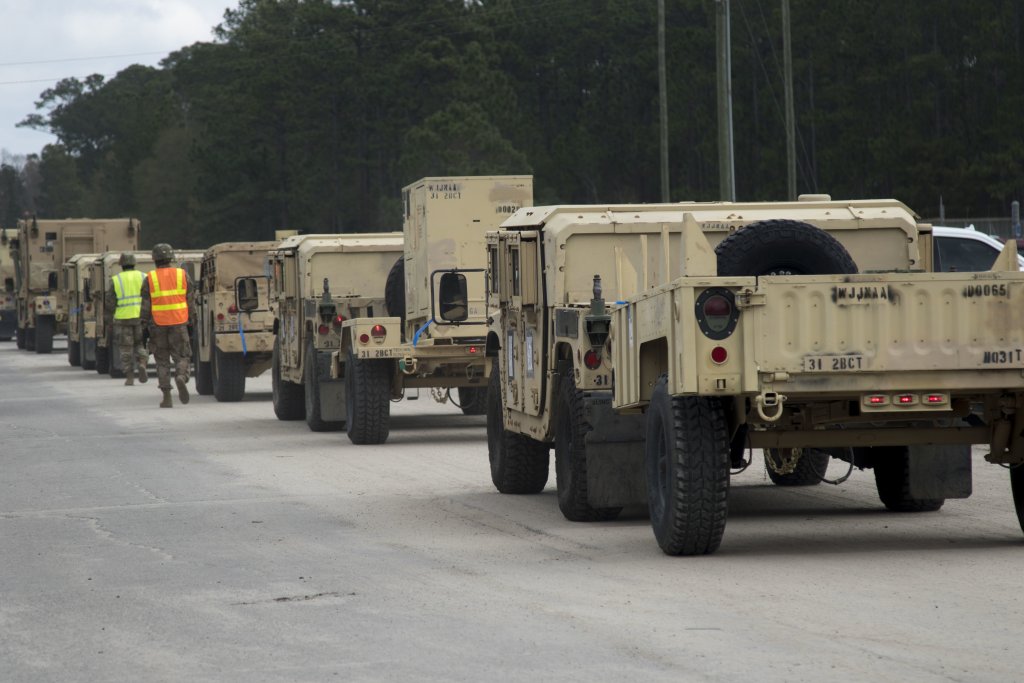-

20,000 soldiers set to deploy for DEFENDER-Europe 20
Reported By RET Q.Morton

A 3rd Infantry Division Soldier performs a convoy brief prior to the movement of military vehicles on Feb. 5, 2020 in Savannah, GA. This movement of equipment is in preparation for the DEFENDER-Europe 20 exercise which takes place in multiple European countries. DEFENDER-Europe 20 will build strategic-level readiness and demonstrate the U.S. military’s ability to rapidly deploy a large combat-credible force in support of the U.S. National Defense Strategy. Photo by Pfc. Carlos Cuebas Fantauzzi
The largest U.S.-based Army exercise of forces to Europe since the Cold War is currently underway.
DEFENDER-Europe 20, a joint, multi-national, U.S. Army Europe-commanded exercise, takes place this spring, with the deployment of 20,000 soldiers from across all components.
Brig. Gen. Sean Bernabe, Deputy Chief of Staff for Operations for U.S. Army Europe, explained the intent of the largest exercise in 25 years.
“Headquarters Department of the Army directed U.S. Army Europe led exercise designed to build strategic readiness for U.S. Army,” Bernabe said. “Twenty-thousand U.S. Army Soldiers, with their assigned equipment, will deploy from the U.S. to Europe and go to training areas around Europe to participate in other smaller exercises.”
Other smaller exercises include:
Exercise Swift Response, an annual multinational parachute operation across Europe;Exercise Saber Strike, a biannual exercise featuring ground maneuver training based in Poland and the Baltic States;
Exercise Allied Spirit, which is focused on interoperability at brigade level and below between allies and partners;
Exercise Dynamic Front, an annual exercise designed to improve interoperability between allied and partner artillery units.
Bernabe added, “Once these smaller exercises are complete, Defender–Europe 20 will redeploy the 20,000 U.S. forces back to the U.S. for their next mission.”
Purpose

Soldiers with 3rd Infantry Division begin convoy operations to Savannah, Georgia, in February as part of preparation for the DEFENDER-Europe 20 exercise which takes place in multiple European countries. Photo by Pfc. Carlos Cuebas Fantauzzi.
Maj. Traun Moore, USAREUR spokesperson, further detailed the exercise’s intent.
“The purpose of DEFENDER-Europe 20 is to demonstrate the U.S. military’s ability to rapidly deploy a large combat-credible force from the U.S. to Europe and, alongside our allies and partners, quickly respond to a potential crisis. Key objectives include units drawing Army prepositioned stock; receiving, staging, moving and integrating units; commanding and controlling a division-size force, rehearsing response options; demonstrating U.S. ability to leverage alliances and partnerships; and testing new equipment,” Moore said.
By the numbers
The exercise will take place from April to May 2020, with personnel and equipment movements occurring from now through July. About 37,000 U.S., allied, and partner nation troops will participate. Of the 20,000 troops deploying from the continental U.S., 7,000 will be Army National Guard soldiers from 12 states and 750 U.S. Army Reserve soldiers. Additionally, 9,000 U.S. troops based in Europe, from the Army, Navy, Air Force and Marines will participate.Objectives
The main objectives of DEFENDER-Europe 20 are the military’s refocus on strategic readiness and continued improvement of interoperability.According to Moore, the military has concentrated on tactical readiness over the last several years. However, emphasis has shifted to building strategic readiness.
“Strategic readiness includes the ability of the U.S. military to dynamically project force and set the theater by mobilizing and deploying forces, sustaining them in a crisis, and redeploying them when their mission is complete,” Moore explained, also clarifying that this exercise is not in response to a specific threat or adversary.
Moore continued, “Interoperability is a state of readiness that we collectively strive to improve … Although this will be the largest movement of U.S. forces to Europe in over 25 years, we are working closely with our allies and partners to ensure a common understanding and enhance our combined readiness and interoperability capabilities. Living and training alongside our allies and partners in Europe helps the U.S. maintain the relationships and trust that are essential for ensuring global security. Interoperability is not only about technology; it is about people and processes — about all participating nations’ militaries developing basic battlefield-critical capabilities like communicating with and understanding allies and partners.”
Preparation

U.S. Army Europe hosted a Rehearsal of Concept drill in February, as a final conditions check for the execution of exercise DEFENDER-Europe 20. Photo by Robert Sekula.
As with any major military operation, units involved — including NATO and host nations — will be organizing and practicing ahead of time. Also, planning conferences will take place prior and throughout each stage of the exercise.
“All participants are in constant communication, to ensure that there is a shared understanding of the key objectives and the steps that are being taken to successfully execute pre-deployment, exercise execution and redeployment operations,” Moore more.
For example, the U.S. Army Europe team is already working with host nation teams “to plan and execute pre-exercise senior leader engagements in participating countries in an effort to further share information about DEFENDER-Europe 20, alongside their host nation counterparts.”
Impact on families
In terms of how this exercise may impact military families, Moore says families should be prepared for their service members to engage in additional training prior to the exercise, as well as resetting when re-deploying from Europe. Though most activity will occur in April and May, pre-deployment training timelines are dependent on the individual unit’s objective. Furthermore, troops and families stationed in Europe and not involved in the exercise, should see minimum impact on their daily lives and experience no interruption of services.





Recommended Comments
There are no comments to display.
Join the conversation
You can post now and register later. If you have an account, sign in now to post with your account.